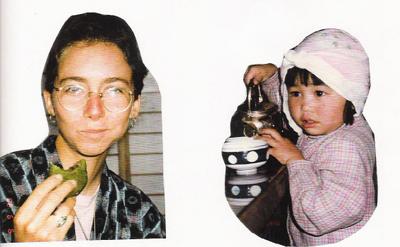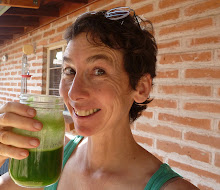
Twenty years ago today, on September 11, 1985, I landed at Narita Airport with my bicycle and my bicycle partner, Kate. We had been bicycling since April. We left our home in Flagstaff, Arizona in an unexpected April blizzard, with just our bicycles, equipped with panniers, camping gear, a small stove, some food, minimal clothing (including rain gear), and bicycle repair tools. We also carried journals, a couple of books each, and a small Olympus 35mm camera.
Our first night out, April 25th, 1985, we camped on the Navajo reservation near the vermillion cliffs in Northern Arizona. Our second night, further north on the rez, a young Navajo man climbed down to the flat ledge where we were camped in our little yellow tent in a small redrock canyon. He'd seen the glow of our candle-lantern illuminating the tent inside and wondered what it was. His grandmother told him to check us out. "We thought you were aliens," he said. In the morning after cooking our breakfast, we were washing out the pot and packing up. We saw the grandmother sitting on the ledge watching us from above.
From Northern Arizona, we cycled through Utah, Idaho, Montana, Washington, British Columbia and Yukon, Canada, then into Alaska. Part of the way we took a ferry. From Seattle, we ferried to Juneau to visit a Tlingit friend and then on to Haines, Alaska. On the ferry, other adventurers slept on the deck in their self-standing dome tents. Our little tent needed pegs, so we slept inside, between the rows of chairs on the main deck. From Haines, Alaska, we rode through BC and Yukon, Canada, and back into Alaska. Starting somewhere along the Salmon River in Idaho we occasionally hung our food at night as a protection against bears. In the mountains and forests of Washington, as well as in Alaska and Canada, we hung our food every night. At campgrounds, large steel "bear lockers" were provided. We put anything that smelled edible or remotely edible to a bear inside the lockers: toothpaste, soap, water bottles, cook pot, eating utensils, all food, chapstick, anything.
We cycled north of Fairbanks and then headed south towards Denali National Park. We stayed about five weeks in the park, camping at the campground. At night, we washed the school buses that took tourists through the park. The 97-mile road out to Wonder Lake was unpaved and dusty, so the buses needed to be washed each night. It seemed like there were a hundred buses to wash every night. Our job was to use high power water hoses on the outside, then to clean and dry the inside and outside, with special attention to cleaning the windows. We worked as efficient teams of about 5 or 6 to a bus. Work usually began at around 8pm and ended at 2 or 3am in the twilight hours when the sky was a turquoise color. We made $13/hour and saved almost 100% of it for our onward journey. We paid no rent--our home was our tent inside the backpackers' and bicyclers camp at Denali--and we cooked all our food. During the days, we hiked, read, relaxed, wrote in our journals, and took short bicycle rides without our gear.
Back in Flag(staff), we had prepared packages of travel food for Alaska/Canada: mixtures of whole grains and beans cracked up in the blender for quicker cooking, oatmeal and bulghur wheat for breakfasts, miso paste, natural ramen, soy jerkey, seaweeds, herbs, vegetable bouillon cubes, dried fruit, chocolate-mint soy milk, ground coffee, dried milk, and lots of granola bars. We mailed boxes of our travel food to five different post offices throughout Alaska.
We used our bus washing earnings to buy our one-way plane tickets to Japan from Anchorage, with onward passage to Hong Kong. We stayed with friends in Anchorage while waiting for our Japan visas. I bought a book, Japanese in 10-Minutes a Day, which included several pages full of stickers of vocabulary words in romaji (roman letters--Japanese words transliterated into our alphabet letters). I had fun putting stickers on objects all over my friends' house and beginning the process of learning Japanese.
Ten days later, we had landed in Japan with our bicycles in boxes. It was late when we arrived and we were too tired to put our bikes back together after we landed. That first night, we took turns sleeping sitting up in the airport and being told to move every couple of hours by the guards. In the morning we dragged our boxes outside and put our bikes back together. I could say jitensha with confidence, so that's what I'd say whenever anyone spoke to us. Jitensha means bicycle. Since I was the language expert (ha-ha) I was in charge of deciphering any signs, maps and oral communication. Well, I was already literate in French and Spanish, had studied some Chinese, knew some prayers and songs in Hebrew, and felt confident that I knew how to learn languages. Kate had happily given up teaching to become a massage therapist, but she also had a Master's degree in teaching ESL from NAU. Kate would likely be the first one of us to obtain employment when it became necessary to do so. At that point, I had worked doing unskilled labor in a printing bindery; had been a camp counselor; had cashiered and handled ordering in a natural foods store; did everything in a whole foods bakery; was a barrista at a café; tutored Spanish, English, and French; did occasional illustration/art jobs; had cleaned houses; worked in a deli; worked at a plant nursery; and took care of children. I had taken about two years of university classes, had no degree, and had never written a resumé. However, In the end we both got jobs teaching English.
* * * * * * * *
Riding a bicycle is a good way to see a place. Most visiting travellers to Japan get off the plane, go through customs, and head for a hotel, hostel, or ryokan. They go by private car, taxi, bus, subway, train, or any combination of these. We got on our bikes and started pedalling out of the airport complex with its nauseating jet fuel fumes, in search of a place to rest in Narita-shi. We rode on the 'other' side of the street than we were accustomed to riding. There were green bamboo trees at the edge of the airport.
In Narita-shi we found a small family run inn. We stayed a few nights to restore our sleep pattern and because we liked the family and Narita-shi. We found ourselves on the second day at a goma 'fire' ceremony performed by Buddhist priests in the main temple at Narita. The temple complex there, Narita-san shinshoji temple and park, is an important pilgrimage place for millions of Buddhist pilgrims in Japan.
Soon we were being ushered in with the crowds. A man told me in English that we should offer something to the fire. All I had with me was my little pocket size Japanese phrase book that I was studying and my passport. So I gave the man both. The priest passed both over the fire and they made their way back into my possession.
I partially credit that goma ceremony for allowing me to get several extensions on my tourist visa plus a change from a tourist visa to a cultural visa without having to leave the country, without even having to go to the Osaka Immigration Office (from Kyoto)--unheard of among all the other English teaching gaijin I knew living in Kyoto. I also credit that I wrote a letter to the immigration officials entirely in Japanese telling them why I wished to stay in Japan (to learn more about the language & culture).
September 11th--the date means different things to different people. For me, I always remember September 11th (1985) as the beginning of some kind of deep learning that continues to this day.

That's me on the left at the inn in Narita-shi eating my favorite Japanese sweet, yomogi genmai mochi with sweet red bean paste in the middle. Yomogi is 'mugwort', a green herb that gives it the color (and is very healthy) and genmai mochi is pounded glutinous brown rice.
On the right, is little Mai-chan, daughter of the inn keepers, three years old, wearing a towel on her head. She adored Kate and followed Kate around everywhere, wearing a towel on her head because Kate wore a bandana on her head.

Here, I am in Sapporo, trying on a wedding kimono at the kimono rental shop of the mother of my friend Yoko's brother's best friend.


No comments:
Post a Comment